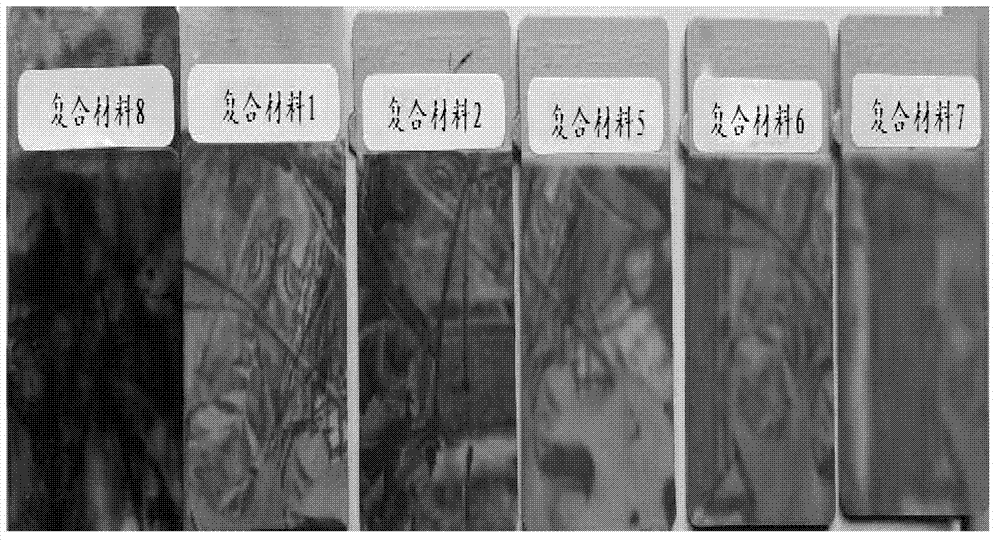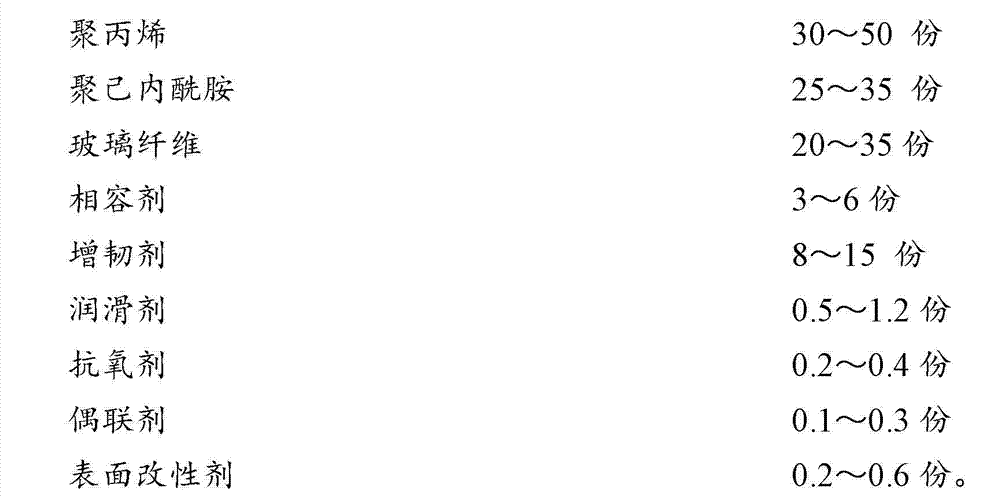Glass fiber reinforced PP/PA6 (Polypropylene/Polyamide6) composite material and preparation method and application thereof
A composite material and glass fiber technology, which is applied in the field of vacuum thermal transfer materials, can solve the problems of low temperature resistance, unclear vacuum thermal transfer patterns, and easy deformation.
- Summary
- Abstract
- Description
- Claims
- Application Information
AI Technical Summary
Problems solved by technology
Method used
Image
Examples
Embodiment 1
[0034] (1) Bake the PA6 resin in an oven at 100°C for 2 hours.
[0035] (2) Weigh 400g of PP resin, 250g of PA6 resin, 30g of maleic anhydride-grafted polypropylene, 80g of maleic anhydride-grafted POE into the mixer, stir at 300 rpm for 3 minutes, then add 2g of γ-aminopropyl tris Ethoxysilane KH550 and 3g liquid epoxy resin, continue stirring at 300 rpm for 3 minutes, then add 3g tetrakis [β-(3,5-di-tert-butyl-4-hydroxyphenyl) propionate] pentaerythritol ester, 5 g of modified ethylene bis fatty acid amide was stirred at 300 rpm for 2 minutes to obtain material A.
[0036] (3) Set the speed frequency of the main extruder to 26HZ, the feeding frequency to 10HZ, the extruder screw The diameter is 36mm, and the length-to-diameter ratio of the extruder is 36:1. In addition, the temperature of each heating zone of the extruder barrel and die head is controlled at 210-235°C. Among them, the heating zone of the extruder barrel includes the 1st to 5th heating zones, and the tempe...
Embodiment 2
[0038] (1) Bake the PA6 resin in an oven at 100°C for 2 hours.
[0039] (2) Weigh 350g of PP resin, 270g of PA6 resin, 30g of maleic anhydride-grafted polypropylene, 100g of maleic anhydride-grafted POE into the mixer, stir at 300 rpm for 3 minutes, then add 2g of γ-aminopropyl tri Ethoxysilane KH550 and 3g of liquid epoxy resin, continue to stir at 300 rpm for 3 minutes, then add 3g of n-octadecyl β-(3,5-di-tert-butyl-4-hydroxyphenyl) propionate, 5g of silicone powder was stirred at 300 rpm for 2 minutes to obtain material A.
[0040] (3) Set the speed frequency of the main extruder to 26HZ, the feeding frequency to 10HZ, the diameter of the extruder screw to 36mm, and the length-to-diameter ratio of the extruder to 36:1. In addition, the temperature of each heating zone of the extruder barrel and die head is controlled at 210-235°C. Among them, the heating zone of the extruder barrel includes the 1st to 5th heating zones, and the temperatures of each heating zone are: 225-2...
Embodiment 3
[0042] (1) Bake the PA6 resin in an oven at 100°C for 2 hours.
[0043](2) Weigh 300g of PP resin, 350g of PA6 resin, 60g of maleic anhydride-grafted polypropylene, 80g of maleic anhydride-grafted polypropylene into the mixer, stir at 300 rpm for 3 minutes, then add 1g of γ-aminopropyl Triethoxysilane KH550 and 2g of liquid epoxy resin, continue stirring at 300 rpm for 3 minutes, then add 3g of n-octadecyl beta-(3,5-di-tert-butyl-4-hydroxyphenyl)propionate 1. 5g of silicone powder was stirred at 300 rpm for 2 minutes to obtain material A.
[0044] (3) Set the speed frequency of the main extruder to 26HZ, the feeding frequency to 10HZ, the diameter of the extruder screw to 36mm, and the length-to-diameter ratio of the extruder to 36:1. In addition, the temperature of each heating zone of the extruder barrel and die head is controlled at 210-235°C. Among them, the heating zone of the extruder barrel includes the 1st to 5th heating zones, and the temperatures of each heating zon...
PUM
| Property | Measurement | Unit |
|---|---|---|
| melt flow index | aaaaa | aaaaa |
| impact strength | aaaaa | aaaaa |
| heat deflection temperature | aaaaa | aaaaa |
Abstract
Description
Claims
Application Information
 Login to View More
Login to View More - R&D
- Intellectual Property
- Life Sciences
- Materials
- Tech Scout
- Unparalleled Data Quality
- Higher Quality Content
- 60% Fewer Hallucinations
Browse by: Latest US Patents, China's latest patents, Technical Efficacy Thesaurus, Application Domain, Technology Topic, Popular Technical Reports.
© 2025 PatSnap. All rights reserved.Legal|Privacy policy|Modern Slavery Act Transparency Statement|Sitemap|About US| Contact US: help@patsnap.com



